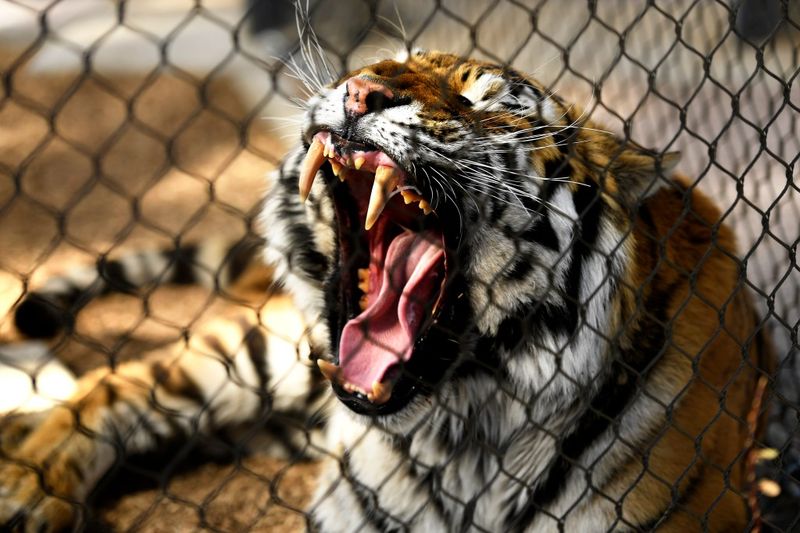Tiger Teeth: Discover The Power Behind These Incredible Fangs

Ever wondered what makes a tiger’s bite so fearsome? Those gleaming fangs aren’t just for show! Tiger teeth are engineering marvels of the natural world, perfectly designed for hunting and survival.
From their impressive length to their specialized functions, these powerful chompers help make tigers the ultimate predators of their domains.
1. Supersized Canines

Imagine fangs as long as your pinky finger! Tiger canines can grow up to 3 inches in length, making them among the longest teeth of any big cat.
These impressive daggers aren’t just for show – they’re precision tools for delivering a fatal bite to prey animals much larger than themselves.
2. Baby Teeth First

Just like human kiddos, tiger cubs are born toothless and develop their first set of baby teeth at around 2-3 weeks old. These temporary pearly whites help them transition from nursing to eating meat.
By 6 months of age, they’ve replaced all 30 of their baby teeth with permanent adult teeth.
3. Carnassial Cutting Power

Behind those famous canines hide specialized slicing tools called carnassial teeth. These act like scissors with serrated edges, designed specifically for shearing through tough muscle and tendons.
When a tiger closes its jaws, these teeth slide past each other like scissors blades, efficiently cutting meat into manageable chunks.
4. Toothache Troubles

Dental problems can be deadly for wild tigers. A broken fang or infected tooth might prevent successful hunting, leading to starvation.
Zoo tigers sometimes receive root canals from specialized veterinary dentists! These dental procedures help captive tigers live longer, healthier lives than their wild counterparts.
5. Pressure-Packed Bite

Talk about jaw power! A tiger’s bite force measures around 1,050 pounds per square inch (PSI) – strong enough to crush bones with ease.
For comparison, that’s about twice the bite force of a lion and nearly ten times stronger than a human’s chomping power. This incredible strength comes from specialized jaw muscles.
6. Precision Hunting Tools

Those iconic canines aren’t just for tearing flesh – they’re precision tools for hunting. Tigers target their bite directly at the prey’s neck, using their canines to slip between the vertebrae.
This technique severs the spinal cord, leading to instant paralysis. Few predators have evolved such an efficient method for immobilizing their prey.
7. Dental Formula Decoded

A tiger’s mouth contains exactly 30 teeth arranged in a specific pattern scientists call a dental formula: I 3/3, C 1/1, P 3/2, M 1/1.
This translates to 3 incisors, 1 canine, 3 premolars, and 1 molar on each side of the upper jaw, with a slightly different arrangement below. Each tooth type serves a specific function!
8. Rough Tongue Partnership

A tiger’s teeth work in tandem with another specialized tool – their sandpaper-rough tongue. While teeth tear and cut, the tongue’s backward-facing papillae help scrape meat from bones.
This tongue is so rough it can lick paint off walls and remove fur and feathers from prey during feeding!
9. Yellow Is Normal

Worried about those yellowish tiger teeth? Don’t be! Unlike humans, tigers naturally have yellow-tinted teeth – it’s not a sign of poor dental hygiene.
The yellow coloration comes from dentine, the tissue beneath enamel, showing through. Wild tigers actually maintain remarkably clean teeth through their natural diet.
10. Self-Sharpening System

Unlike humans who need dental tools, tigers maintain razor-sharp teeth naturally. Their canines continuously wear against each other during normal jaw movements, creating a self-sharpening effect.
This ingenious system ensures their primary hunting weapons stay sharp throughout their lifetime without any special maintenance.
11. Ancient Saber Connection

Modern tiger teeth have prehistoric cousins! Saber-toothed cats like Smilodon had even longer canines, some reaching 7 inches.
While today’s tigers evolved a different hunting style, they share a common ancestor with these ancient predators. Their teeth represent different evolutionary solutions to the same problem: efficient prey capture.
12. Tooth Replacement Limits

Unlike some reptiles that continuously replace teeth throughout life, tigers get just two sets – baby teeth and adult teeth. Once their permanent teeth are damaged or lost, they’re gone for good.
Old tigers with worn or missing teeth often struggle to hunt effectively, making dental health crucial for survival.
13. Grooming Toothpicks

Those tiny front teeth aren’t just for show! Tigers use their small incisors as precision grooming tools, almost like built-in toothpicks.
Watch a tiger groom and you might see it carefully picking out parasites, splinters, or bits of food from its fur using these specialized teeth. They’re particularly useful for removing ticks and thorns.
14. Poaching Threat

Tragically, tiger teeth have become valuable targets for poachers. In some Asian markets, tiger fangs fetch thousands of dollars for use in traditional medicines, despite no proven medical benefits.
This illegal trade threatens already endangered tiger populations, with fewer than 4,000 wild tigers remaining worldwide.






